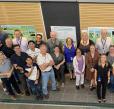The page you requested does not exist. For your convenience, a search was performed below using the query Shorebirds links to NSW Victorian curricula.
PFAS chemicals in packaging pose serious environmental and health risks, but Australia’s packaging industry is leading the way to phase them out. Backed by cutting-edge nuclear science, industry-led action is creating safer packaging solutions for all Australians.
Recent news, highlights, and impact case studies from CAS’ research and industry user communities and collaborations/partners
Evidence of the earliest occupation of the coasts of Australia from Barrow Island, Northwest Australia.

Accelerator Operator
Role at ANSTO
Accelerator Operator.
ANSTO to receive a new grant to continue to fight chronic kidney disease killer in Sri Lanka.
Today is World Environment Day, a United Nations initiative for encouraging worldwide awareness and action for the environment. This year’s theme is “Beat Air Pollution”, a call to action to combat this global crisis.
ANSTO is participating in a major project to learn more about an important component of the atmosphere, the hydroxyl radical.

Leader, Nuclear Fuel Cycle Research
Role at ANSTO

Principal Research Scientist
Role at ANSTO
Health researchers at ANSTO use world-class nuclear and isotopic techniques to undertake research and development activities to address some of the most challenging health problems.
Particle induced X-ray emission can be used for quantitative analysis in archaeology, geology, biology, materials science and environmental pollution.
More than 3,200 solar panels have been installed across the rooftops of the Australian Nuclear Science and Technology Organisation’s (ANSTO) Australian Synchrotron in Clayton, offsetting enough power to light up the whole MCG for more than five years.

Radiation Biologist
Role at ANSTO
Nick is a radiation biologist who works for the NST Human Health research theme.
ANSTO has a range of capabilities and expertise to support aerospace and space research.
Research is undertaken to characterise and optimise the beneficial impacts of radiation on living matter
The Centre for Acclerator Science operates accelerators that can be used for space radiation testing.
ANSTO renewed its Memorandum of Understanding (MOU) with the Japan Proton Accelerator Research Complex (J-PARC) operated by the High Energy Accelerator Research Organisation (KEK) and Japan Atomic Energy Agency (JAEA). Now broadened to include their partner Comprehensive Research Organization for Science and Society (CROSS), the signing took place early in the year and a celebratory workshop was held late July.
Pagination











